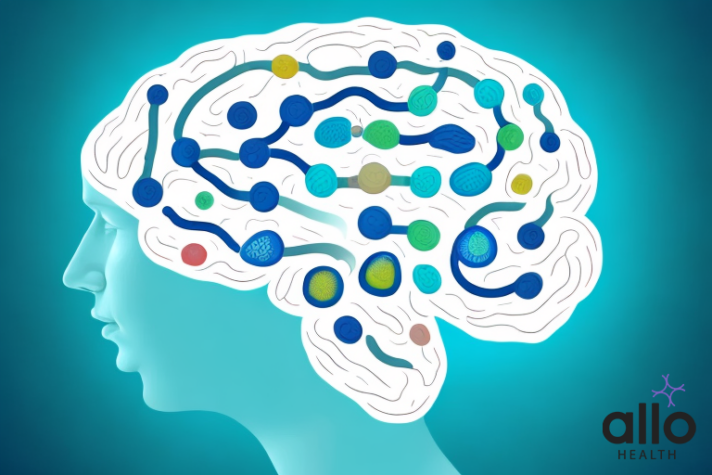Is HIV Genetic?

Allo Health is dedicated to personalized well-being, offering support and trusted information tailored to individual health goals. The platform emphasizes human-generated content, led by a distinguished medical team of experts, including physicians and sexual health specialists. Their commitment to credibility involves rigorous fact-checking, authoritative research, and continuous updates to ensure accurate, up-to-date information. Allo Health's unique approach goes beyond conventional platforms, providing expert-led insights and a continuous commitment to excellence, with user feedback playing a crucial role in shaping the platform's authoritative voice.

Dr Sanina Mansoor holds MBBS degree from Yenepoya university,Mangalore.She has 8 years of experience working as a medical officer at various health centres and medical colleges.
Why This Was Upated?
Our experts continually monitor the health and wellness space, and we update our articles when new information became available.
Updated on 05 June, 2024
- Article was updated as part of our commitment to diversity, equity, and inclusion.

"The following blog article provides general information and insights on various topics. However, it is important to note that the information presented is not intended as professional advice in any specific field or area. The content of this blog is for general educational and informational purposes only.
Book consultation
The content should not be interpreted as endorsement, recommendation, or guarantee of any product, service, or information mentioned. Readers are solely responsible for the decisions and actions they take based on the information provided in this blog. It is essential to exercise individual judgment, critical thinking, and personal responsibility when applying or implementing any information or suggestions discussed in the blog."
“Is HIV Genetic?” explores the complex relationship between HIV and genetics. While HIV itself is not inherited genetically, certain genetic factors can influence susceptibility to the virus and the progression of the disease. This introduction delves into the interplay between HIV infection and genetic predispositions, shedding light on how variations in human genes can impact susceptibility, transmission, and treatment outcomes. Understanding the genetic components of HIV provides valuable insights for developing personalized prevention strategies and more effective treatments in the ongoing battle against this global health challenge.
What Is HIV And How Does It Work?

- HIV (Human Immunodeficiency Virus) is a virus that attacks the immune system, specifically targeting CD4 cells.
- It weakens the immune system, making it difficult for the body to fight off infections and diseases.
- HIV spreads through certain bodily fluids, including blood, semen, vaginal fluids, and breast milk.
- The most common modes of risk of transmission are unprotected sex, sharing needles, and from mother to child during pregnancy, childbirth, or breastfeeding.
- Without treatment, HIV can progress to AIDS (acquired immunodeficiency syndrome), the late stage of HIV infection, where the immune system is severely compromised, leading to life-threatening illnesses.
Understanding The Structure and Function Of HIV
- HIV (Human Immunodeficiency Virus) is a retrovirus that attacks the immune system.
- It primarily targets CD4 cells, weakening the body’s ability to fight infections.
- HIV can lead to AIDS (acquired immunodeficiency syndrome) if left untreated.
- The virus enters the body through bodily fluids such as blood, semen, vaginal fluids, and breast milk.
- HIV transmission occurs through unprotected sex, sharing needles, and from mother to child during childbirth or breastfeeding.
- Antiretroviral therapy (ART) can suppress HIV replication and prevent progression to AIDS.
- Understanding HIV’s structure and function is crucial for prevention, treatment, and combating stigma.
How Does HIV Infect Human Cells?

- HIV infects human cells primarily through binding to CD4 receptors on the surface of immune cells.
- The virus enters the cell by fusing its envelope with the cell membrane.
- Once inside, HIV releases its genetic material, RNA, into the cell.
- The viral RNA is then converted into DNA by the enzyme reverse transcriptase.
- This viral DNA is integrated into the host cell’s DNA by the enzyme integrase.
- The infected cell begins producing new viral particles, which can then infect other cells.
- HIV primarily targets CD4+ T cells, weakening the immune system over time.
The Different Types and Subtypes Of HIV
- HIV, or Human Immunodeficiency Virus, has several types and subtypes.
- The main types are HIV-1 and HIV-2, with HIV-1 being the most common worldwide.
- HIV-1 is further categorized into subtypes, such as A, B, C, D, and more.
- Subtype B is predominant in the Americas and Western Europe.
- Subtype C is prevalent in sub-Saharan Africa, the most affected region.
- HIV-2 is mainly found in West Africa.
- Each subtype may exhibit slightly different characteristics, affecting risk of transmission rates, progression of the disease, and response to treatment.
The Genetic Makeup Of HIV: RNA vs DNA Virus

- HIV (Human Immunodeficiency Virus) is a retrovirus with RNA as its genetic material.
- RNA viruses like HIV have a high mutation rate due to the error-prone nature of RNA replication.
- This high mutation rate leads to rapid evolution and the emergence of drug-resistant strains.
- HIV’s RNA genome must be converted into DNA by the enzyme reverse transcriptase to integrate into the host cell’s genome.
- Once integrated, HIV’s DNA directs the host cell to produce new viral RNA and proteins (amino acid sequences), perpetuating the opportunistic infection cycle.
- Understanding HIV’s genetic makeup is crucial for developing effective treatments and vaccines.
How Does HIV Replicate Itself?
- HIV replicates itself through a process called reverse transcription.
- The virus attaches to CD4 cells, a type of white blood cell in the immune system (immune mediators).
- It injects its genetic material, RNA, into the CD4 cell.
- The viral enzyme reverse transcriptase converts the viral RNA into DNA (Viral evolution).
- The newly formed viral DNA integrates into the host cell’s DNA.
- The host cell machinery then produces new viral RNA and proteins (cell response).
- These components assemble into new virus particles.
- The new viruses bud off from the host cell, ready to infect other CD4 cells, perpetuating the cycle.
The Role of Viral Mutations in HIV Infection and Drug Resistance

- Viral mutations play a critical role in HIV infection and drug resistance.
- Mutations in HIV’s genetic material can lead to changes in viral proteins, affecting drug efficacy.
- Drug resistance occurs when mutations allow the virus to evade the effects of antiretroviral medications.
- High mutation rates in HIV, combined with rapid replication, contribute to the development of drug-resistant strains.
- Monitoring viral mutations is crucial for designing effective treatment strategies and developing new drugs.
- Understanding the mechanisms of mutation helps in combating HIV and preventing the spread of drug-resistant strains.
Can HIV Be Inherited Genetically: Is HIV Genetic?
While HIV itself is not inherited genetically, there are genetic factors that can affect a person’s susceptibility to the virus and its progression. For example, certain genetic variations in the CCR5 gene have been shown to provide natural resistance to HIV infection. Other genetic factors, such as the HLA genes, can affect the body’s immune response to HIV and the effectiveness of antiretroviral therapy.
In addition to genetic factors, environmental factors can also play a role in HIV transmission and progression. For instance, individuals who live in poverty or have limited access to healthcare may be at a higher risk of contracting HIV and developing AIDS. Additionally, lifestyle factors such as drug use and unprotected sex can increase the likelihood of HIV transmission. It is important to note that while HIV cannot be inherited genetically, it can be transmitted from mother to child during pregnancy, childbirth, or breastfeeding. However, with proper medical care and treatment, the risk of mother-to-child risk of transmission can be greatly reduced.
The Connection Between Host Genetics and HIV Susceptibility
- Host genetics play a significant role in determining susceptibility to HIV infection.
- Certain genetic variations can impact the immune response to HIV, affecting the likelihood of opportunistic infections.
- Variants in genes encoding for HIV co-receptors, such as CCR5, can influence viral entry into cells.
- Polymorphisms in genes related to immune function, like HLA genes, can affect the body’s ability to mount an effective defense against HIV.
- Genetic factors also influence the progression of HIV infection to AIDS, with some individuals showing slower disease progression due to specific genetic profiles.
- Understanding the genetic basis of HIV susceptibility can inform the development of personalized prevention strategies, such as targeted vaccines or pre-exposure prophylaxis (PrEP).
How Genetic Testing Can Help Manage HIV Treatment
- Genetic testing can reveal insights into how an individual’s body processes HIV medications.
- It can identify genetic variations that affect drug metabolism and treatment efficacy.
- This information helps doctors prescribe the most effective medications with minimal side effects.
- Testing can predict a patient’s response to certain HIV drugs, optimizing treatment plans.
- It aids in avoiding adverse reactions and drug resistance by tailoring therapy to individual genetic profiles.
- Genetic testing contributes to personalized medicine, improving HIV management and overall patient outcomes.
Current Advances in Gene Therapy for HIV Cure
- CRISPR/Cas9: Precision gene editing tool used to target HIV-infected cells.
- Lentiviral vectors: Deliver therapeutic genes into patients’ cells to enhance the immune response against HIV.
- Stem cell transplantation: Engineered stem cells with HIV-resistant genes replace infected cells.
- Immune checkpoint inhibitors: Boost the immune system to recognize and eliminate HIV-infected cells.
- Long-acting antiretroviral therapy: Sustained drug delivery to suppress HIV replication.
- Gene silencing: RNA-based therapies inhibit HIV replication within cells.
- Clinical trials: Testing novel gene therapy approaches for safety and efficacy in HIV patients.
- Challenges: Addressing off-target effects, immune response, and ethical considerations for widespread adoption.
Future Directions in Understanding the Genetic Basis Of HIV/AIDS
- Integration of advanced genomic technologies to map genetic variations associated with HIV/AIDS susceptibility and progression.
- Exploration of host genetics to elucidate factors influencing viral replication, immune response, and treatment outcomes.
- Identification of novel gene targets for therapeutic interventions and vaccine development.
- Integration of multi-omics approaches (genomics, transcriptomics, proteomics) to unravel complex interactions between host genetics and viral factors.
- Utilization of large-scale genome-wide association studies (GWAS) and population level of genetics to elucidate genetic determinants of HIV/AIDS disparities.
- Application of CRISPR-based gene editing for understanding host-virus interactions and potential gene therapies.
Most Asked Questions
-
Is HIV genetic?
No, HIV is not genetic in the traditional sense—it's a virus transmitted through specific behaviors like unprotected sex or sharing needles. However, HIV can affect genetic material by integrating its genetic material into the host's DNA.
-
Can HIV be inherited genetically?
HIV itself is not inherited genetically from parent to child. However, there is a genetic component in how susceptible individuals are to HIV infection and how their bodies respond to the virus.
-
Are there genetic factors influencing HIV transmission?
Yes, certain genetic variations can affect susceptibility to HIV infection. For example, mutations in the CCR5 gene can make individuals more resistant to HIV.
-
How do genetics affect HIV progression?
Genetic factors play a role in how quickly HIV progresses to AIDS. Some individuals have genetic variations that lead to slower disease progression, while others may experience rapid decline.
-
Can genetic testing predict HIV susceptibility?
Genetic testing can provide insights into an individual's susceptibility to HIV infection. However, it's essential to remember that genetic testing alone cannot determine HIV risk—it's just one factor among many.






































